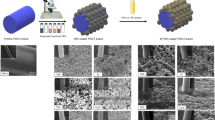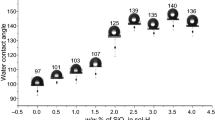Abstract
Bacterial infection from medical devices is a significant problem and accounts for an increasing number of deaths and high medical costs. Surgical sutures are a major source of nosocomial infection through surgical wound contamination and the rates of which are increasing globally. One efficient way to prevent this is by modifying the surface of the sutures in such a way that no bacterial adhesion can occur. In this investigation, biodegradable polymer sutures with excellent antibacterial properties were developed. Antibacterial properties were achieved by coating nanosilver incorporated biopolymer polycaprolactone material on the surface of the sutures. Biocompatible polyethylene glycol was selected as the solvent for the dispersion of nanosilver particles, which improved the mechanical properties of the sutures. The nanoparticle coating was found to be uniform and more effective with the electrospinning method. The mechanical property of the coated suture was analysed using the Universal Test Method, and the results were in agreement with the standard results. The surface morphology of coated sutures becomes uniform on adding nanosilver particles, confirmed by scanning electron microscope studies. A comparative study of force–displacement, hardness, and reduced modulus as a function of contact depth indentation tests were performed on coated and uncoated suture samples using a Nanoindentation Test Machine. In-situ Scanning Probe Microscopy images were captured for coated and uncoated suture materials. These studies confirmed a new strategy in developing antibacterial sutures suitable for wound closure following surgery.








Similar content being viewed by others
References
Mangram AJ, Horan TC, Pearson ML, Silver LC, Jarvis WR (1999) Am J Infect Control 27:97134
Suárez GJ, De Toro CM, Docobo DF, Rubio CC, Martín CJ, Docobo PF (2007) Cir Esp 8:324–329
Huang L, Taylor H, Gerber M, Orndorff PE, Horton JR, Tonelli A (1999) J Appl Polym Sci 74:937–947
Jennifer RL, Patchen D (2016) Hosp Med Clin 5:319–333
Joseph B, George A, Gopi S, Kalarikkal N, Thomas S (2017) Int J Pharm 524(1–2):454–466
Leknes KN, Roynstrand IT, Selvig KA (2005) J Periodontol 7:634–642
Raveendran P, Jie F, Wallen SL (2003) J Am Chem Soc 125:13940–13941
Scott VE, John GY (2016) Shock 46(6):597–608
Leaper D, McBain AJ, Kramer A (2010) Ann R Coll Surg Engl 92:453–458
Hranjec T, Swenson BR, Sawyer RG (2010) Surg Infect 11:289–294
Edmiston CE, Seabrook GR, Goheen MP, Krepel CJ, Johnson CP, Lewis BD, Brown KR, Town JB (2006) J Am Coll Surg 203:481–489
Wang L, Chen DD, Sunt JQ (2009) Langmuir 25:7990–7994
Levy SB, Marshall B (2004) Nat Med 10:122–129
Yan L, Kushi NK, Jeffrey MD, Meagan C, Richard WS, Klaus N, Gregory NT (2012) Langmuir 28(33):12134–12139
Li W-R, Xie X-B, Shi Q-S, Zeng H-Y, Ou-Yang Y-S, Chen Y-B (2010) Appl Microbiol Biotechnol 85:1115–1122
Menno LWK, Leo HK (2011) Polymers 3:340–366
Sondi I, Salopek-Sondi B (2004) J Colloid Interface Sci 275:177–182
Ip M, Lui SL, Poon VKM, Lung I, Burd A (2006) J Med Microbiol 55:59–63
Chen J, Han CM, Lin XW, Tang ZJ, Su SJ (2006) Chin J Surg 44:50–63
Cohen MS, Stern JM, Vanni AJ, Kelley RS, Baumgart E, Field D, Libertino JA, Summerhayes IC (2007) Surg Infect 8:397–403
López SF, Flores RG, López SJ, Magariños B, Alvarez LC, Concheiro A, Bucio E (2018) Eur Polymer J 100:290–297
Padmakumar S, Joseph J, Neppalli MH, Mathew SE, Nair SV, Shankarappa SA, Menon D (2016) ACS Appl Mater Interfaces 8(11):6925–6934
Justinger CI, Schuld J, Sperling J, Kollmar O, Richter S, Schilling MK (2011) Langenbecks Arch Surg 396:845–850
Marcjanna MG, Björn W, Valérie D, Thomas E, Regine WR (2018) Materials 11(12):2561
Acknowledgements
The financial support of HLL Lifecare Ltd is greatly acknowledged.
Author information
Authors and Affiliations
Corresponding author
Ethics declarations
Conflict of interest
The authors declare that they have no conflict of interest.
Additional information
Publisher's Note
Springer Nature remains neutral with regard to jurisdictional claims in published maps and institutional affiliations.
Rights and permissions
About this article
Cite this article
James, B., Ramakrishnan, R. & Aprem, A.S. Development of Environmentally Safe Biodegradable, Antibacterial Surgical Sutures Using Nanosilver Particles. J Polym Environ 29, 2282–2288 (2021). https://doi.org/10.1007/s10924-021-02048-y
Accepted:
Published:
Issue Date:
DOI: https://doi.org/10.1007/s10924-021-02048-y




